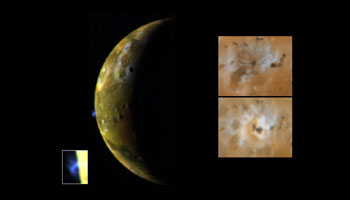Data from NASA's Galileo spacecraft have provided scientists evidence of what appears to be a body of liquid water, equal in volume to the North American Great Lakes, beneath the icy surface of Jupiter's moon, Europa, the U.S. space agency announced Wednesday.

Europa, which is slightly smaller than Earth's moon, is believed to have a large ocean of salty water deep beneath its frozen crust. Galileo spacecraft, launched by the space shuttle Atlantis in 1989, studied Jupiter, which is the most massive planet in the solar system, and some of its many moons.
Pictures of it sent back by Galileo point to a tortured surface of cracks and jumbled ice. Seeking to understand how such weird topography evolved in a place with such dim sunlight, scientists believe that the answer lies in similar processes on Earth.
Their model suggests that Europa's ice shell is about 10 kilometers thick and within it are giant pockets of water, lying at depths as shallow as three kilometers. Warm water from these sub-surface lakes wells up in plumes, causing the ice to become brittle, crack and then collapse. The ice turnover would be a plus for the prospects for life, as it would transfer energy and nutrients between the sub-glacial lake and the surface.
"One opinion in the scientific community has been if the ice shell is thick, that's bad for biology. That might mean the surface isn't communicating with the underlying ocean," said Britney Schmidt, lead author of the paper and postdoctoral fellow at the Institute for Geophysics, University of Texas at Austin. " Now, we see evidence that it's a thick ice shell that can mix vigorously and new evidence for giant shallow lakes. That could make Europa and its ocean more habitable."
"The data opens up some compelling possibilities," said Mary Voytek, director of NASA's Astrobiology Program. "However, scientists worldwide will want to take a close look at this analysis and review the data before we can fully appreciate the implication of these results."
VietNamNet/Xinhuanet